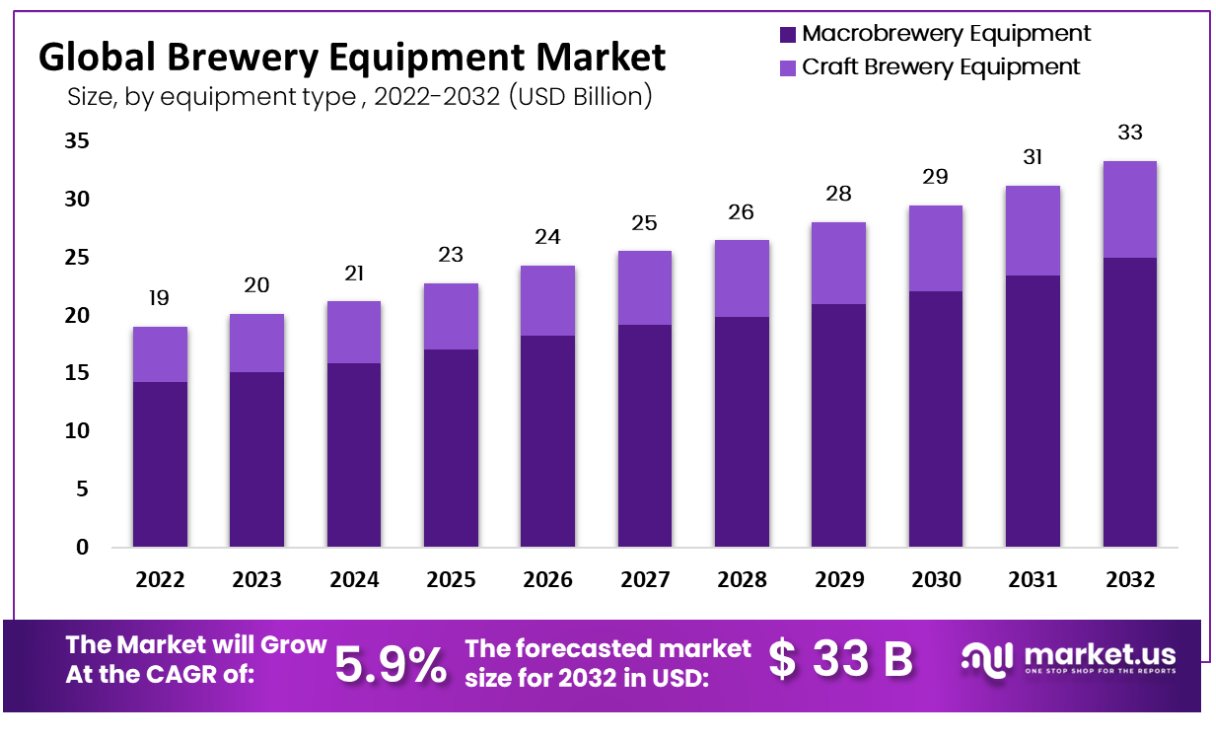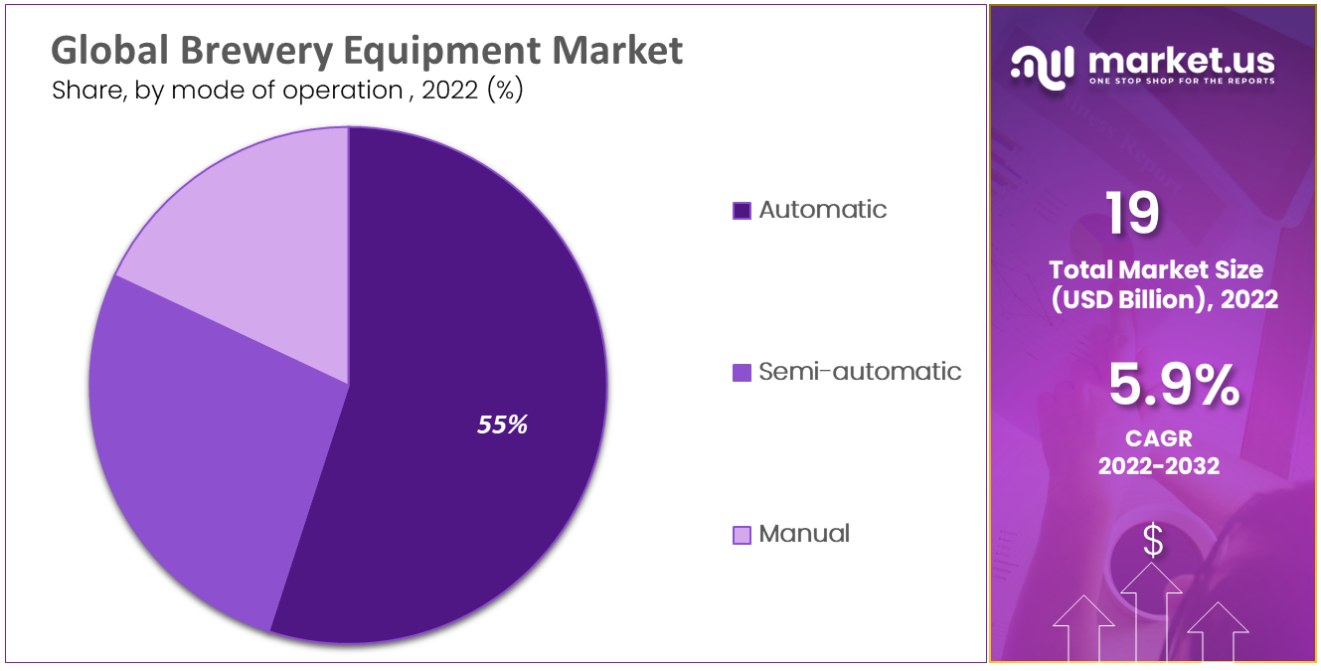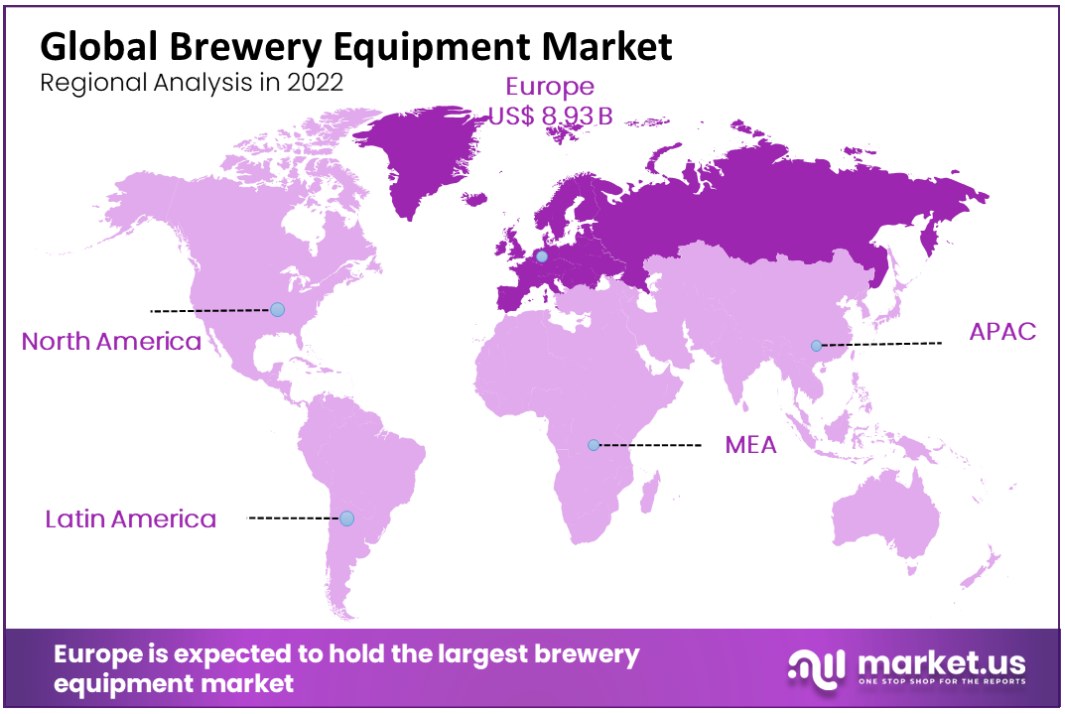Global Brewery Equipment Market, By Equipment Type (Macrobrewery Equipment, and Craft Brewery Equipment), By Mode of Operation, By Brewery Type, By Region and Companies - Industry Segment Outlook, Market Assessment, Competition Scenario, Trends, and Forecast 2023-2032
- Published date: Oct 2023
- Report ID: 47422
- Number of Pages: 316
- Format:
- keyboard_arrow_up
Quick Navigation
Report Overview
The Global Brewery Equipment Market size is expected to be worth around USD 33.0 Billion by 2032 from USD 19 Billion in 2022, growing at a CAGR of 5.90% during the forecast period from 2023 to 2032.
The global brewery equipment market refers to the market for equipment used in the production of beer and other fermented beverages. The market includes equipment used for brewing, fermenting, and packaging beer and also for maintaining the temperature and cleanliness of the brewing environment.
Over the past few years, the growth rate of alcohol consumption has more or less been constant while the demand for spirits has been gradually rising.
Over many centuries, alcohol has played an important role in social interaction and bonding. Alcoholic beverages such as beer, wine, ale, and lager, as well as other varieties, are now frequently served at social gatherings. Manufacturers and brewers have increased output as a result of a rise in alcohol use to meet the growing demand, particularly for beer as well as wine.
Breweries have sprouted up recently, particularly in developing nations, to cater to the growing urban middle class, whose way of life has become heavily reliant on alcoholic beverages. Breweries’ growth has consequently increased demand for affordable as well as high-quality brewing equipment. The brewing equipment market is one of the most profitable markets to invest in owing to the availability of a variety of beverages and beverage makers.
Key Takeaways:
- Rapid growth: The brewery equipment market is booming all over the world, driven by the growing popularity of craft beers and the rise of microbreweries. This expansion isn’t restricted to the traditional regions that produce beer It’s a global phenomenon.
- technological advancements: Brewery equipment manufacturers continue to innovate to meet the changing needs of beer makers. Automatization, efficiency in energy use, and sustainability are a few of the most important areas of technological advancement that will result in greener and more efficient brewery processes.
- Consolidation The craft beer industry flourishing however, there is an increasing trend of consolidation between brewery owners. Breweries that are larger are buying smaller ones, which influences the need for brewery-specific equipment. Craft-oriented equipment that is smaller in size is still required, but there is also a need for more sophisticated, larger equipment.
- Sustainable: Sustainable development is one of the significant aspects in the world of brewery equipment. Breweries are increasingly adopting environmentally friendly methods and equipment. This includes energy-efficient brewing methods as well as water conservation and recyclable and reusable packaging. These are significant for both regulators and consumers.
- Global Expansion Breweries are seeking to expand their reach across the globe which is resulting in an increase in demand for equipment for brewing in new markets. This is triggered by the desire to expand their reach and introduce a range of beers across different regions.

Driving Factors
Increasing Demand for Craft Beer: The rise in the popularity of craft beer has resulted in an increased demand for brewery equipment. As more and more microbreweries are established, the demand for equipment such as mash tunes, fomenters as well kegging systems is expected to increase.
Growing Number of Brewpubs and Bars: The number of brewpubs and bars is on the rise globally, which is driving the demand for brewery equipment. These establishments require specialized equipment such as dispensing systems, kegs also refrigeration units.
Technological Advancements: The brewery equipment market has witnessed several technological advancements over the years. These advancements have led to the development of high-quality equipment that is more efficient as well as cost-effective, thereby driving the demand for brewery equipment.
Increasing Disposable Income: With an increase in disposable income, consumers are willing to pay more for premium beer. This has led to an increased demand for high-quality brewery equipment that can produce premium beer.
Government Support: Governments across the globe are providing support to the brewery industry through subsidies also tax incentives. This has encouraged many entrepreneurs to establish microbreweries, thereby driving the demand for brewery equipment.
Sustainability: The focus on sustainable practices has increased in the brewing industry, leading to a demand for more energy-efficient and environmentally friendly equipment. Many breweries are investing in modern equipment that can help reduce their carbon footprint.
Restraining Factors
The initial cost of setting up a brewery can be quite high, with the cost of brewery equipment being a significant portion of that investment. This can be a significant barrier to entry for new players in the market. The market for brewery equipment is relatively small compared to other industries, which can limit the growth potential of companies operating in this space.
The availability and cost of raw materials, such as hops also barley, can have a significant impact on the profitability of breweries. Fluctuations in the price or availability of these materials can pose a challenge to the brewery equipment market.
The brewery industry is subject to strict regulations regarding the production and sale of alcohol, which can pose a challenge for companies operating in this space. The brewery equipment market is highly competitive, with a large number of players operating in the space.
This can make it difficult for companies to stand out also gain market share. The growing popularity of alternative beverages, such as hard seltzers also kombucha, could pose a threat to the brewery industry as well thus to the brewery equipment market.
COVID-19 Impact Analysis
Due to the pandemic, consumer behavior has altered, and more people are opting to drink at home rather than in bars and clubs. Home brewing supplies are now more in demand, somewhat offsetting the market decline. Nonetheless, the outbreak has a detrimental effect generally, and it will probably take some time for the market to fully recover.
The brewing equipment market is predicted to gradually rebound once the economy picks up and restrictions on bars, restaurants, and pubs are eased. The increased popularity of craft beer, particularly in developing nations, is predicted to be a key factor in the market for brewery equipment’s long-term growth. Additionally, it is projected that the rising popularity of online beer purchases as well as home delivery would encourage business expansion.
When the economy improves and the limitations on bars, restaurants, and pubs are relaxed, the market for brewing equipment is anticipated to gradually return. Long-term growth of the brewery equipment market is anticipated to be driven by the rising popularity of craft beer, particularly in emerging regions. As well, the growing popularity of online beer sales also home delivery is anticipated to promote industry expansion.
Overall, while the pandemic has had a significant impact on the Brewery Equipment Market, the long-term outlook for the market remains positive. The market is expected to recover gradually, driven by the growing demand for craft beer. The increasing trend of home brewing and online sales.
By Equipment Type Analysis
Based on equipment type, microbrewery equipment market dominates the market with a 75% market share. This sector is predicted to maintain its dominance in the coming days as the demand for a standard style of beer rises owing to the simple availability of beer from various brands at varying price ranges. The usage of this equipment is ideal for mass-producing beer.
The part on macro brewery equipment can be further divided into sections on cooling, brewing, filtration, filling, and fermenting equipment. This category also comprises equipment such as waste grain silos, bright beer tanks, generators, as well as pipes. There will be a rise in the need for high-capacity machinery used in large-scale beer manufacturing.
Equipment for craft breweries is anticipated to grow during the forecast period. Craft beer’s distinctive flavor and all-natural ingredients are contributing to its rising global popularity. Many health advantages are offered, such as a decreased risk of diabetes, arthritis as well cardiovascular disease. Craft beer consumption is expanding, which supports the craft brewery equipment market.
Mode of Operation Analysis
By mode of operation, automatic mode dominates the market with a 55% market share. Automatic operation systems are designed to streamline the brewing process by automating certain tasks, such as ingredient addition, temperature control as well fermentation monitoring.
Automatic operation systems use sensors and programmable logic controllers (PLCs) to automate these tasks. Sensors can monitor various parameters, such as temperature, pressure, as well flow rate also provide real-time feedback to the PLC.
The PLC then uses this information to adjust the system accordingly, such as adjusting the temperature of the mash or controlling the flow rate. In addition to improving efficiency and consistency in the brewing process, automatic operation systems can also help reduce labor costs and minimize the risk of human error. They can also provide data logging or reporting capabilities, allowing brewers to track and analyze data over time to improve their processes and optimize their equipment.

The use of automatic operation systems in the global brewery equipment market is becoming increasingly common as brewers look for ways to improve their efficiency as well as maintain consistent quality in their products.
By Brewery Type Analysis
Based on brewery type, the microbreweries segment dominates the market with a 69% market share. Microbreweries are large-scale industrial facilities that produce large quantities of beer for mass consumption. These breweries use highly automated and sophisticated brewing equipment to produce consistent and uniform beer batches.
Microbreweries typically use a variety of specialized equipment to carry out each step of the brewing process, including mills, mash tuns, boilers, fomenters, conditioning tanks also bottling or canning lines. The beer produced by microbreweries is typically designed to have a consistent flavor profile that is easily recognizable as well appealing to a wide audience. These breweries often use a blend of different types of malt, hops as well other ingredients to achieve this desired flavor profile.
Key Market Segments:
Based on Equipment Type
- Microbrewery Equipment
- Milling Equipment
- Brew House
- Cooling Equipment
- Fermentation Equipment
- Filtration & Filling Equipment
- Others
- Craft Brewery Equipment
- Mashing Equipment
- Fermentation Equipment
- Cooling Equipment
- Storage Equipment
- Compressors
- Others
Based on the Mode of Operation
- Automatic
- Semi-automatic
- Manual
Based on the Brewery Type
- Microbreweries
- Craft breweries
Growth Opportunities
The brewery equipment market presents a considerable commercial opportunity for businesses in this sector. The market has experienced recent substantial growth as the result of the development of microbreweries also brewpubs as well as the increased demand from consumers for craft beer. One of the key factors influencing this market is the growth of the craft beer industry, which has experienced a rise in popularity across numerous continents.
Owing to the increase in breweries, particularly small and medium-sized ones, it is now necessary to use specialized equipment to produce their unique beer blends. The growing trend towards value, where customers are prepared to pay more for high-quality as well as distinctive beer products, is another driver pushing the market for brewery equipment. Such as the, there is now a need for specialized machinery that can generate a greater variety of beer flavors also types.
The market for brewery equipment is also being driven by the growing use of automation as well as digital technology in the brewing process, in addition to these other factors. As a result, more advanced brewing machinery has been created, which can boost output and consistency while also raising quality.
Overall, the market for brewery equipment offers a sizable opportunity for companies in this industry. To fulfill the evolving requirements of their customers, businesses will need to keep innovating as well as creating new products and services as the market gets more competitive.
Latest Trends
Increase in Craft Beer Production: The desire for smaller, more adaptable brewery equipment that can handle smaller batches and distinctive beer flavors has increased as craft beer’s popularity has grown. As a result, the creation of microbreweries and brewpubs has increased, requiring smaller, more adaptable equipment.
Technological Advancements: Like many other sectors, the brewery equipment market is heavily influenced by technology. Automation and control technologies are being used more frequently to enhance brewing efficiency and accuracy, cut labor costs, and guarantee consistent quality.
Sustainability: The importance of sustainability is growing in the brewery industry, and this is reflected in the equipment being used. There is the increasing use of energy-efficient equipment, as well as equipment that reduces water usage and waste. Brewers are also looking for ways to repurpose or recycle brewing byproducts such as spent grains.
Asia-Pacific Region: The Asia-Pacific region is becoming a major market for brewery equipment, due to the increasing popularity of beer in countries such as China, India, and Japan. This is driving demand for new as well as more efficient equipment to support the growth of the brewing industry in these countries.
E-commerce and Direct-to-Consumer Sales: With the rise of e-commerce and direct-to-consumer sales, there is a growing market for smaller, more affordable home brewing equipment. This is driving innovation in the design also functionality of smaller brewing systems, making it easier for consumers to brew their beer at home.
Regional Analysis
Europe dominates the brewery equipment market with a 47% market share. Europe is a major market for brewery equipment, owing to the presence of several large beer brewing companies such as Anheuser-Busch InBev, Heineken, and Carlsberg.
Germany, the United Kingdom as well Belgium are the leading markets in this region. In terms of equipment type, the brewing tanks segment is expected to dominate the market in Europe, owing to the high demand for fermentation tanks in the beer production process.
The filtration equipment segment is also expected to grow at a significant rate, driven by the increasing demand for high-quality beer as well as the need to remove impurities from the beer.
The Asia-Pacific brewery equipment market is expected to grow rapidly owing to the increasing demand for beer in countries such as China, India, and Japan. China is the largest market in this region, followed by Japan and Australia

Key Regions and Countries
- North America
- The US
- Canada
- Mexico
- Western Europe
- Germany
- France
- The UK
- Spain
- Italy
- Portugal
- Ireland
- Austria
- Switzerland
- Benelux
- Nordic
- Rest of Western Europe
- Eastern Europe
- Russia
- Poland
- The Czech Republic
- Greece
- Rest of Eastern Europe
- APAC
- China
- Japan
- South Korea
- India
- Australia & New Zealand
- Indonesia
- Malaysia
- Philippines
- Singapore
- Thailand
- Vietnam
- Rest of APAC
- Latin America
- Brazil
- Colombia
- Chile
- Argentina
- Costa Rica
- Rest of Latin America
- Middle East & Africa
- Algeria
- Egypt
- Israel
- Kuwait
- Nigeria
- Saudi Arabia
- South Africa
- Turkey
- United Arab Emirates
- Rest of MEA
The global market for brewery equipment is extremely fragmented, with a sizable number of domestic and international manufacturers. Brewery equipment manufacturers offer a wide-ranging distribution network that enables their customers to be located all over the world.
Enterprises competing in the worldwide market face major challenges from growing regional market competition also an increase in companies selling affordable brewing equipment. Also, growing R&D initiatives by significant market players to produce also sell superior brewing equipment may act as a deterrent to new entrants.
Market Key Players:
- ALFA LAVAL
- GEA Group Aktiengesellschaft
- Krones AG
- PAUL MUELLER COMPANY
- CRIVELLER GROUP
- DELLA TOFFOLA USA
- SCHULZ
- Hypro
- Praj Industries
- ABE Equipment
- Ampco Pumps Company
- BREWBILT MANUFACTURING INC
- LEHUI
- DEUTSCHE BEVERAGE TECHNOLOGY
- MEURA
- Other Key Players
Recent Developments:
- In April 2022- Alfa Laval provided the brewery systems to Golden Brewery. The second-largest brewery in the world and the biggest in the US is Golden Brewery. It is anticipated that the company’s brewing business segment will grow as a result of this prospect.
- On 11 January 2020- The Springfield Brewing Company announced a US$1.0 million expansion project that included the installation of eight stainless steel fermentation tanks from Paul Mueller.
Report Scope:
Report Features Description Market Value (2022) USD 19 Bn Forecast Revenue (2032) USD 33 Bn CAGR (2023-2032) 5.9% Base Year for Estimation 2022 Historic Period 2016-2022 Forecast Period 2023-2032 Report Coverage Revenue Forecast, Market Dynamics, COVID-19 Impact, Competitive Landscape, Recent Developments Segments Covered By Equipment Type, By Mode of Operation, By Brewery Type Regional Analysis North America – The US, Canada,&Mexico; Western Europe – Germany, France, The UK, Spain, Italy, Portugal, Ireland, Austria, Switzerland, Benelux, Nordic, &Rest of Western Europe; Eastern Europe – Russia, Poland, The Czech Republic, Greece, & Rest of Eastern Europe; APAC – China, Japan, South Korea, India, Australia & New Zealand, Indonesia, Malaysia, Philippines, Singapore, Thailand, Vietnam, &Rest of APAC; Latin America – Brazil, Colombia, Chile, Argentina, Costa Rica, & Rest of Latin America; the Middle East & Africa – Algeria, Egypt, Israel, Kuwait, Nigeria, Saudi Arabia, South Africa, Turkey, United Arab Emirates, &Rest of MEA Competitive Landscape ABE Equipment Praj Industries, Krones AG Customization Scope Customization for segments, region/country-level will be provided. Moreover, additional customization can be done based on the requirements. Purchase Options We have three licenses to opt for Single User License, Multi-User License (Up to 5 Users), Corporate Use License (Unlimited User and Printable PDF) Frequently Asked Questions (FAQ)
Q: What are the segments covered in the Brewery Equipment market report?A: Market.US has segmented the Brewery Equipment market by geography (North America, Europe, APAC, South America, and the Middle East and Africa). By Type, the market has been segmented into Craft Brewery Equipment and Macrobrewery Equipment. By Mode of Operation, the market has been further divided into Manual, Semi-automatic, and Automatic. By End-Use, the market is further divided into Craft Brewery and Macro Brewery.
Q: Who are the key players in the Brewery Equipment market?A: Alfa Laval AB, Krones AG, GEA Group AG, Paul Mueller, Della Toffola SpA, Criveller Group, Hypro Group, Kaspar Schulz, and Other Key Players are engaged in Brewery Equipment Market.
Q: Which region is more attractive for vendors in the Brewery Equipment market?A: North America accounted for the largest revenue share of 47%, among the other regions. Therefore, North America Brewery Equipment market is expected to garner significant business opportunities for the vendors during the forecast period.
Q: What are the key markets for Brewery Equipment?A: Key markets for Brewery Equipment are the US, China, Japan, India, Brazil, Germany, UK, France, Italy, Spain, etc.
Q: Which segment has the largest share in the Brewery Equipment market?A: In the Brewery Equipment market, vendors should focus on grabbing business opportunities from the chewable form segment as it accounted for the largest market share in the base year.

- ALFA LAVAL
- GEA Group Aktiengesellschaft
- Krones AG
- PAUL MUELLER COMPANY
- CRIVELLER GROUP
- DELLA TOFFOLA USA
- SCHULZ
- Hypro
- Praj Industries
- ABE Equipment
- Ampco Pumps Company
- BREWBILT MANUFACTURING INC
- LEHUI
- DEUTSCHE BEVERAGE TECHNOLOGY
- MEURA
- Other Key Players
- settingsSettings
Our Clients
| Single User $4,599 $3,499 USD / per unit save 24% | Multi User $5,999 $4,299 USD / per unit save 28% | Corporate User $7,299 $4,999 USD / per unit save 32% | |
|---|---|---|---|
| e-Access | |||
| Report Library Access | |||
| Data Set (Excel) | |||
| Company Profile Library Access | |||
| Interactive Dashboard | |||
| Free Custumization | No | up to 10 hrs work | up to 30 hrs work |
| Accessibility | 1 User | 2-5 User | Unlimited |
| Analyst Support | up to 20 hrs | up to 40 hrs | up to 50 hrs |
| Benefit | Up to 20% off on next purchase | Up to 25% off on next purchase | Up to 30% off on next purchase |
| Buy Now ($ 3,499) | Buy Now ($ 4,299) | Buy Now ($ 4,999) |












